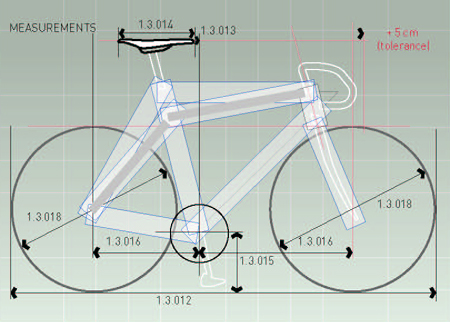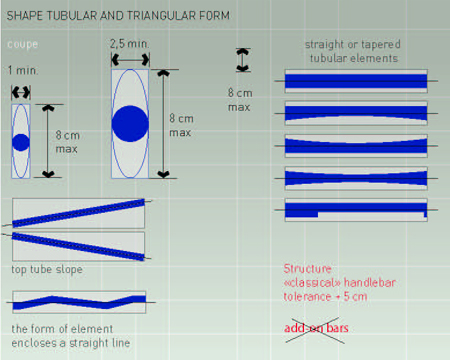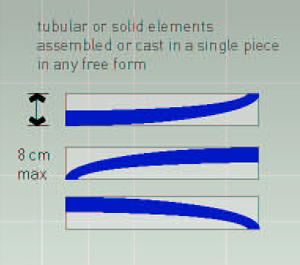Understanding the New UCI Regs: Part 2
 Fri, June 19, 2009
Fri, June 19, 2009 
Bicycle design used to be simple. For 100 years frames were steel, tubes were round, and the tubes remained pretty much a standard diameter throughout the world.
Then during the late 1980s early 1990s frames molded in carbon fiber began to appear. No matter how the frame is assembled, the finished frame has the appearance of being all one piece.
There are no tubes, (At least not round in the traditional sense.) the UCI refers to the parts as elements. Up until now there were no guidelines as to the size and shape of these frame elements.
For many years now the UCI has had in place a set of rules governing the geometry of a bicycle. (In particular, the frame.) These consist of maximum and minimum measurements; here is an example of a few.
Bottom bracket height from the ground, can be between 24cm. and 30cm. Distance from the center of the bottom bracket to center of front wheel, 54cm. to 65cm. Rear centers, (Chainstay length.) 35cm to 50cm.
These measurements have not changed. It allows a framebuilder or manufacturer plenty of scope to design and build a frame to suit any rider.
These measurements can be found in this document; (Starting at page 56, click on the page symbol at the left side of your screen to bring up thumbnail pages, scroll down and click on p.56.) The drawing at the top of this article gives the page numbers in that document where the maximum and minimum limits can be found.
The UCI has always disallowed any form of added on streamlining. Their rule is simple; if it is part of the structure it is okay. For years they would not allow a skin over the spokes of a wheel; considered streamlining not structural. It was not until wheels could be molded so the outside skin or shell actually supports the rim, were they allowed.
Who can say, with an irregular shaped molded frame, what is streamlining and what is structural? You can’t, so the UCI has laid down some standard parameters regulating the dimensions of the elements of the frame. As before there is a maximum and a minimum dimension, but not a restriction as to the shape of the element within the stipulated size.
The elements can be round, oval, triangular or any other shape, as long as the cross section is within an 8cm. maximum by 2.5cm. minimum the narrowest way. The measurement is 8cm. x 1cm. for the seatstays.
The elements can also be any shape along their length; curved, tapered, etc., as long as they do not go outside the 8cm. wide box, also, the form of the element has to enclose a straight center line. See the picture below.

There is another regulation that may be a little confusing to some. The depth and width of the elements have to work out to a 1 to 3 ratio. If the element is the maximum 8cm one way then it has to be 8cm divide by 3 which equals 2.66 wide minimum instead of 2.5.
If the manufacturer chooses to opt for the minimum width of 2.5cm. then the measurement the widest way will be, 2.5 x 3 = 7.5cm maximum instead of 8cm.
 Seatstays seem a little unclear, but my translation is still a 3 to 1 ratio which would be 8cm. (Max.) x 2.66cm. (Min.) for the maximum size.
Seatstays seem a little unclear, but my translation is still a 3 to 1 ratio which would be 8cm. (Max.) x 2.66cm. (Min.) for the maximum size.
3cm. (Max.) x 1cm. (Min.) would be the minimum allowed.
If the seatstays and chainstays are curved they should fall within an 8cm wide box.
The rest of the new addendum can be viewed here.
I can’t see where these new restrictions will stifle R&D. It still allows individual manufactures to each make their own unique design frame within these parameters.
With any sport, not just cycling, there must be rules governing the equipment used for that sport. My comment is that these rules had to come into play for the sake of some sort of uniformity in bicycle design.
My view is, it should have been done much sooner when it became clear that CF frames were going to be the standard racing equipment of the future. However, it wasn’t, so better now that later.
Also only my opinion, pros will still ride special bikes built just for them as they have always done, and no one will know (Or even care.) because the bikes will be built within these UCI specifications.
It will stop the publicity seeking, “Million Dollar” bike, circus acts in the future. Maybe that will be a good thing; there will be more focus on the important thing, the sport of cycle racing and the person riding the bike rather than the bike itself.
 Dave Moulton | Comments Off |
Dave Moulton | Comments Off |  Comment
Comment 
















Reader Comments (3)
A good round up to a good post thanks Dave. it's good to hear someone talk sense.
Thank you, that's a great synopsis. I completely agree with your assertion that there is still enough scope within the rules for a lot of innovation.
One thing that isn't said here is that it doesn't stop a manufacturer from building a bike outside these boundaries. It does not stifle R&D it only limits the equipment used in UCI sanctioned one-design bicycle races. Tri bikes, recumbents, streamlined bikes and what ever else can still race in the IHPVA events. I hope this update encourages the creation of a development bicycle racing class. Maybe even UCI will incorporate unlimited development classes in their racing schedule. That would further the science of the bicycle which has been limited by having only one racing class for a long time, essentially a one design class. To draw from another sport, The America's Cup boat would not exist if all racing had been limited to the Sabot for the last couple of hundred years.